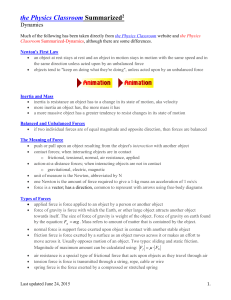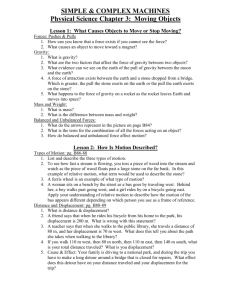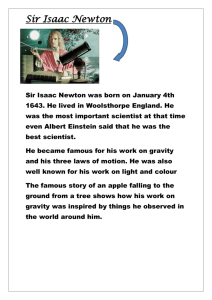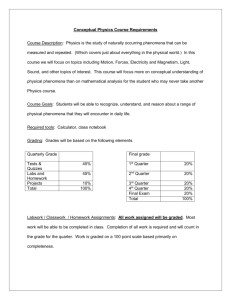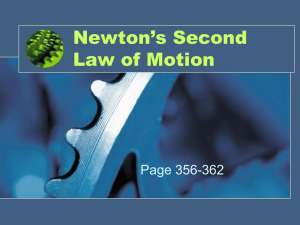Lecture 5: projectile motion and circular motion
advertisement
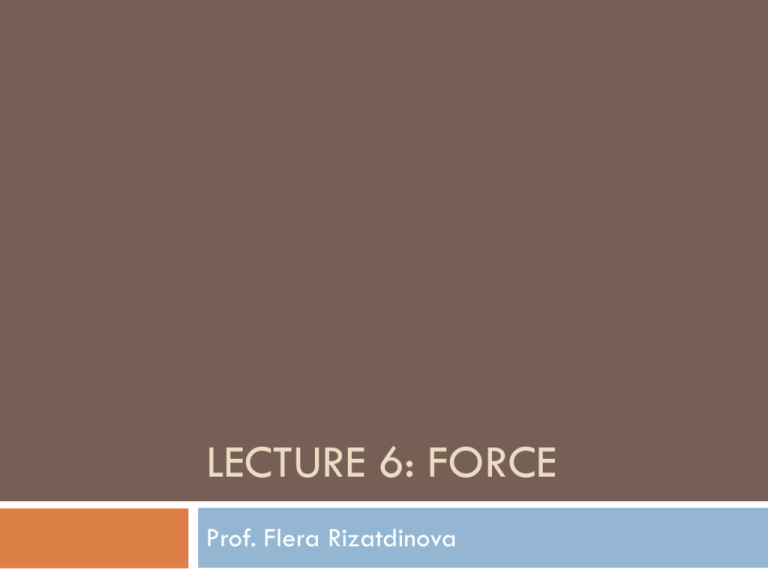
LECTURE 6: FORCE Prof. Flera Rizatdinova Example 2 (From lecture 5) A boy whirls a stone in a horizontal circle of radius of 1.5 m and height 2m above level ground. The string breaks, and the stone flies off horizontally and strikes ground after traveling a horizontal distance of 10 m. What is the magnitude of the centripetal acceleration of the stone during the circular motion? Solution: y y0 12 gt 2 y 0; y0 2m t 2 y0 / g R v0 x t v0 x R/t R / 2 y0 / g R (range) = 10 m; v=v0x, so v = 15.8 m/s a v2 r a 15.82 1.5 166.7m / s 2 Nonuniform Circular Motion 3 If an object moves in a circular path but its speed changes, then this is nonuniform circular motion. If an object moves in a circular path but its speed changes, then this is nonuniform circular motion. Radial acceleration keeps the object in circular motion The parallel component of acceleration is called tangential acceleration (because it is tangent to the circle) – it changes the speed but not the direction. Force and Motion Chapter 4 Dynamics We would like to be able to explain why motion of the object is changing – this is subject of dynamics. Examples of changing of motion: Stopping Starting the motion Speeding up Slowing down Sir Isaac Newton From Wikipedia: Sir Isaac Newton, (4 January 1643 – 31 March 1727 [OS: 25 December 1642 – 20 March 1726]) was an English physicist, mathematician, astronomer, natural philosopher, alchemist, and theologian and one of the most influential men in human history. His Philosophiæ Naturalis Principia Mathematica, published in 1687, is considered to be the most influential book in the history of science. In this work, Newton described universal gravitation and the three laws of motion, laying the groundwork for classical mechanics, which dominated the scientific view of the physical Universe for the next three centuries and is the basis for modern engineering. Force Force: push or pull Force is a vector – it has magnitude and direction Forces we know from everyday’s life 1) Gravity 2) Friction 3) Restoring force (springs) 4) Tension 5) … (a lot of others) So, what is the force? Newton’s first law Newton reasoned that a moving object possessed some “quantity of motion” that, in effect, kept it going. But what was this quantity? Could it be force? No! Galileo showed that the ancient idea that force is needed to keep something moving is wrong. Newton’s First Law Law of Inertia (discovered by Galileo) A body in uniform motion remains in uniform motion, and a body at rest remains at rest, unless acted upon by a nonzero net force. That is, if the forces on an object cancel the object’s motion will not change. Newton’s First Law Newton concluded that the appropriate “quantity of motion” is momentum p mv the product of the mass and the velocity. Note that like velocity, momentum is a vector. Newton’s Second Law Law of Motion The rate at which a body’s momentum changes is equal to the net force acting on the body: Fnet dp dt Newton’s Second Law Fnet dp dt d (mv ) dt dm dv v m dt dt Newton’s 2nd law of motion becomes much simpler if the mass is constant: Fnet dv m dt ma Example 1 F F A 1100 kg car traveling at 27 m/s starts to decelerate and comes to a complete stop in 578 m. What is the average braking force acting on the car? Solution: ma; v 2f vi2 2a 1100 0.63 x 693N a vi2 (2 x) 0.63 m s 2 Clicker question An object is moving to the right in a straight line. The net force acting on the object is also directed to the right, but the magnitude of the force is decreasing with time. The object will 1) continue to move to the right, with its speed increasing with time 2) continue to move to the right, with its speed decreasing with time 3) continue to move to the right with constant speed 4) stop and then begin moving to the left F = ma v Example 2 There are two forces on 2 kg box in the overhead view, but only one is shown. For F1= 20N, a=12 m/s2 and =30°, find the second force F1 In a unit-verctor notation Its magnitude a Solution: Fnet F1 F2 ; ma ma1 ma2 a a2 x ax ay a1 a1x ; a2 y ax a sin ; a y a2 x 12 sin 30 F2 x ma2 x a1 y ; a1x a cos ; 20 / 2 8N ; F2 y a1 a2 a1 y 0 Now we can calculate components of a2 4m/s 2 ; a2 y 20.8N 10.4m/s 2 Magnitude: F2 Finally: F22x Fyx2 21.9 N Inertia We can rewrite Newton’s 2nd law for constant mass as follows: a Fnet m This shows that mass is a measure of a body’s resistance to changes in motion, that is, mass measures a body’s inertia. The greater the mass, the greater the inertia. Inertia If no force acts on an object, an inertial reference frame is any frame in which there is no acceleration on an the object. In (a) the plane is flying horizontally at constant speed, and the tennis ball does not move horizontally. In (b) the pilot suddenly opens the throttle and the plane rapidly gains speed, so that the tennis ball accelerates toward the back of the plane. Inertia is the tendency of mass to resist acceleration, so that a force must be supplied to overcome inertia and produce acceleration. Inertia The SI unit of force is defined as follows: a force of 1 newton (N) accelerates an object of mass 1-kg at 1 m/s2. Since F = ma, N = kg m/s2. Forces Gravity Tension Compression Contact Friction Electromagnetic These forces, and ones that are less familiar, can be reduced to just three fundamental ones. The Fundamental Forces Gravity ~ 10-2 – 10-5 Tension, compression, contact, friction, electric, magnetic,… Strong Force Significant on large scales Electroweak Force ~ 10-39 ~1 Operates within protons and neutrons For those who are interested in learning more about that, go to http://www.particleadventure.org – you’ll have a lot of fun! No formulas, just explanation of how objects interact with each other The Fundamental Forces A basic question of current physics is: do the fundamental forces unify? European Center for Particle Physics http://www.cern.ch The Force of Gravity Mass and weight are different things. Mass is a measure of inertia. Weight is the force that gravity exerts on a body. It is not the downward force of gravity, but the normal force exerted by the surface one stands on, which opposes gravity and prevents one from falling to the center of the Earth. This normal force is called the apparent weight. Example: A person with mass of 78 kg is riding in elevator which is accelerating upward at 1.8 m/s2. What is the person’s apparent weight? W = m(a+g) = 78 (1.8+9.8) = 905 N The Force of Gravity Near the Earth’s surface, the weight of a stationary body (body that does NOT move w.r.t ground), that is, the force exerted on it by gravity is given by w mg where the magnitude of the vector g = 9.8 m/s2. Example: A 1-kg object will have the same mass on the Moon as on Earth, but will weigh less on the Moon than on Earth. (Acceleration of gravity is only 1.6 m/s2 on the Moon) Clicker question 2 If I weigh 702 N on Earth and 5320 N on the surface if a nearby planet, what is the acceleration due to gravity on that planet? 1) 2) 3) 4) 5) 74.3 m/s2 54.2 m/s2 64.6 m/s2 85.5 m/s2 5.3 m/s2 Weightlessness Aren’t astronauts “weightless”? No. At typical space-shuttle altitudes, the acceleration of gravity is about 93% of its value at Earth’s surface, so the gravitational forces on the shuttle and its occupants are almost the same as on Earth.

